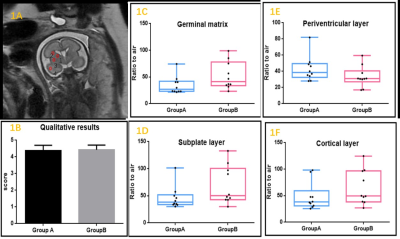Le Cao1, Xiang Liu1,2, and Jianxin Guo1
1The First Affiliated Hospital of Xi’an Jiaotong University, Xi’an, Shaanxi,, China, 2The First Affiliated Hospital of Xi’an Jiaotong University, Xi’an, Shaanxi, China
Synopsis
3.0T
MR scanner can achieve superior image quality depicting fetal anatomic details
over 1.5T, but may poses higher risk of adverse impact on fetal auditory
development due to its intrinsically higher acoustic noise level. This
comparative study investigated the value of acoustic noise reduction technique
in fetal exam. The result shows the technique can acquire equivalent quality
images in 3.0T scanner, meanwhile decrease hearing loss risk in fetal head
examinations compared with the conventional method.
Background
Since
the first fetal MR imaging was performed in 1983, the technique
has developed vastly in the past 3 decades with the improvement of fetus image
quality. Previous studies suggested that there was no adverse effect of
exposure to 1.5T MR imaging in utero on neonatal hearing function, while Joel’s advised that it
seems prudent to avoid more than 1.5T MRI for pregnant women. On the other hand, existing
evidences indicate that compared to 1.5T MRI, 3.0T system achieves better
anatomical delineation in fetal imaging. However, concern remains on the risk
of hearing damage as well as aggravated fetal movement artifacts induced by the
elevated acoustic noise level. How can we reduce the impact of noise while
acquiring high resolution images in 3.0T? Our study compared the acoustic level
and image quality with and without acoustic reduction technique (ART). The
purpose of this study was to evaluate whether ART is reliable and applicable in
fetus brain imaging.Method
The
Institutional Review Board approved this study and all the written informed
consents were obtained from pregnant woman. Images were continuously collected
from September 2017 to October 2018 using 3.0T MR scanner (Discovery 750W; GE
Medical system, Milwaukee, WI) for fetal head exams. 10 subjects underwent ART
sequences (group A), the matched 10 subjects underwent traditional sequences
(group B). The protocol of tradition sequences includes T2 single short fast
spin echo (SSFSE) (axial, sagittal, coronal); while the ART sequences contains
ART T2 SSFSE (axial, sagittal, coronal) (Table1). The ART used in our study
intentionally decrease the slew rate of gradient waveform from 12 Guass/cm/ms
to 5 Guass/cm/ms to achieve lower acoustic noise level. Noise of each sequence
at different sites was measured using a special noise meter (BSWA 801; Beijing
Shengwang Acoustic and Electromagnetic Technology), each of which was tested
for 20 seconds and measured continuously for 3 times for average value. A
quantitative assessment by the ROI of 1 mm was manually placed on the different
layers of the brain (Fig 1A): germinal matrix, periventricular layer, subplate
layer, and cortical layer. The mean signal intensity for each layer was
collected, and comparative ratio to air was calculated4. A qualitative
evaluation including eight criteria (1. Delineation of germinal zone and gray
matter, 2. Delineation of white matter, 3. Delineation of internal and external
CSF spaces, 4. Delineation of amniotic fluid adjacent to the skull,
5.Delineation of brain stem, 6. Delineation of cerebellum, 7. Severity of
motion artifacts, 8. Overall image quality) were evaluated on an ordinal scale
regarding signal characteristics, potential dysmorphism and developmental
anomalies (5= optimal diagnostic quality; 4= very good image quality;3=
diagnostic image quality, 2= image quality below diagnostic standards; 1= image
quality too poor to correctly identify anatomy)5. The noise and image quality
differences between the two groups were compared. Statistical analysis was
performed in SPSS 20.0 and P value less than 0.05 was considered to indicate
statistical significance.Results
There
was no statistical difference between the demographic data of the two groups.
The maximum differences of peak and equivalent sound pressure between the two
groups are 18.1dBA and 16.1dBA respectively (Table2), indicating the ART
sequences have lower noise than traditional sequences. Comparative ratios
calculated between germinal matrix/air, periventricular layer/air, subplate
layer/air, and cortical layer/air for group A (33.97±17.52, 42.45±16.65, 46.37±22.46,
43.03±20.89) were lower than that of group B (52.54±25.61, 33.39±12.91,
69.17±35.21, 64.76±32.53), but with no significant difference (P=0.09,0.20,
0.12, 0.11) (Fig1C-F). The qualitative results showed that the image quality of
group B and group A scored 4.42 + 0.37 and 4.36 + 0.49 respectively(Fig1B).
There was no significant difference in image quality score between the two
groups. The detailed information is summarized in Table3.Conclusion
Acoustic
reduction sequence can acquire high quality images in 3.0T scanner, meanwhile
decrease hearing loss risk in fetal head examinations compared with the
conventional method. Acknowledgements
No acknowledgement found.References
1. Smith FW, Adam AH and Phillips WD. NMR
imaging in pregnancy. Lancet. 1983;
321: 61-2.
2. Strizek B, Jani JC, Mucyo E, et al. Safety of MR Imaging at 1.5
T in Fetuses: A Retrospective Case-Control Study of Birth Weights and the
Effects of Acoustic Noise. Radiology.
2015; 275: 530.
3. Ray JG, Vermeulen MJ, Bharatha A, Montanera WJ and Park AL.
Association Between MRI Exposure During Pregnancy and Fetal and Childhood
Outcomes. Jama. 2016; 316: 952-61.
4. Priego G, Barrowman NJ, Hurteaumiller J and Miller E. Does 3T
Fetal MRI Improve Image Resolution of Normal Brain Structures between 20 and 24
Weeks' Gestational Age? American Journal
of Neuroradiology. 2017; 38.
5. Bonel H, Frei KA, Raio L, Meyer-Wittkopf M, Remonda L and Wiest
R. Prospective navigator-echo-based real-time triggering of fetal head movement
for the reduction of artifacts. European
Radiology. 2008; 18: 822-9.
6. Noise: a hazard for the fetus and newborn. American Academy of
Pediatrics. Committee on Environmental Health. Pediatrics. 1997; 100: 724-7.



